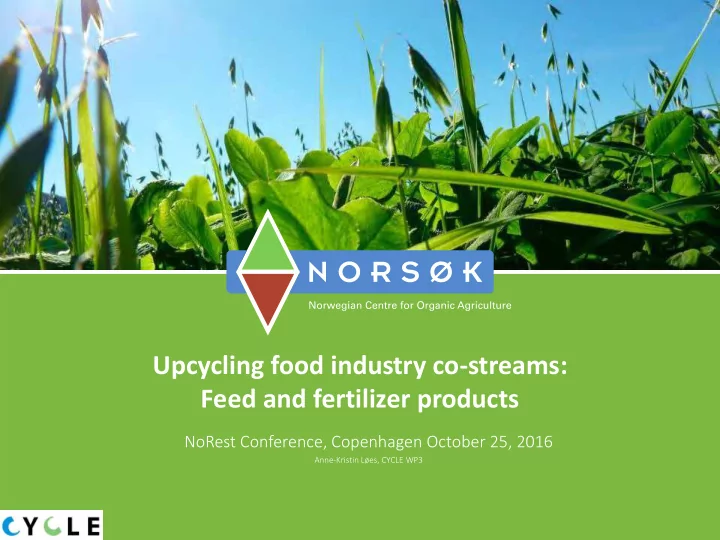

Upcycling food industry co-streams: Feed and fertilizer products NoRest Conference, Copenhagen October 25, 2016 Anne-Kristin Løes, CYCLE WP3
CYCLE project (2013-16): Processing co-streams from food industry to design innovative food, feed and fertilizer products BACKGROUND: We throw away 50% of our food….. CYCLE aims at reducing food waste by increasing resource utilization in the food industry Industry-oriented science for food innovation
Chicken, vegs and fish Scientists co-operate with industry partners in three important Norwegian food chains: • Chicken • Vegetables and potatoes • White and pelagic fish
Residual terminology Further reading: • Waste: To be discarded; food waste has negative connotations • Loss: Decrease in mass of edible food along food chain • Co-streams: By-products or residual raw materials, resources for further utilisation CYCLE team touring Norway June 2013; here at Norilia chicken slaughterhouse
Products studied in WP3 • Eggshell for liming • Feathers for protein feed • Left-over potatoes and vegetables for feed • Residual soil/sludge for fertilizer after composting • Bone residues for P, N fertilizer, hydrochar • Digestate for hydrochar • Seaweed for hydrochar Feathers: Topic for Steffen Adler’s CYCLE post-doc
Eggshell for liming • 800 tons available annually at Norilia, Revetal • Effect on soil pH comparable to traditional limestone (pH 6.1 6.3) • Ca-AL in soil increased much more with eggshell (109 160 mg/100 g soil vs no change for traditional lime) • Indicates higher bioavailability of minerals in eggshell • Likely better to use for food or feed 8 g eggshell application than liming per egg Field trial with Jon Erik Knotten, Re, Vestfold 2013
Feathers for protein feed • Feathers cut, mixed with degrading enzymes, hydrolyzed with NaOH and Na 2 SO 3 • Amounts of dissolved (L) and residual (R) proteins analyzed by freeze-drying • In vitro pepsin digestibility (IVD) measured • Amino acid composition analyzed
Essential amino acid requirement for salmon vs. content in feather meal Toxic by overfeeding Low content; needs supplement
Left-over potatoes and vegetables for feed • First step: Potatoes compressed in round bales as silage, with beet pulp • Good quality feed analyses after 12 weeks • Challenging, but possible 1400 kg, 30 % DM to make compressed potatoes stick together
Left-over potatoes and vegetables for feed • Second step: Spin-off project SOCAPRO (RFF MIDT) • Ensiling may improve feed value and extend shelf life • Potatoes (2) and carrots (3), with wheat bran (4) and hay (5) • Probiotic bacteria can have beneficial effects on gut health in e.g. pigs and calves • Studies of pH, runoff, bacteria survival, palatability
Residual soil/sludge for fertilizer after composting Compost reactor Colorado beetle • Out-sorted potatoes and residual soil are currently deposited for plant safety reasons • Better option: Reactor- composting for cheap sanitation? • To be studied at Skjetlein in cooperation with GGE • Two proposals for spin- High temp (55 °C) in decomposing off projects; no funding horse manure Cysts from potato nematode
Bone residues for P, N fertilizer: Oil Hydrochar Emulsion • De-meated chicken bones (from mechanical deboning of meat) were Dissolved ground for hydrolyzation of oil and proteins proteins • Sediment rich in C, N and P, high content of minerals • Hydrothermal carbonization (HTC) can be used to produce stable liquid and solid phase (hydrochar) Sediment • A chemical process simulating natural «grakse» coal formation • “Pressure boiling” of aqueous organic substrates at moderate temperatures: 180-250 ° C, 14-200 bars
HTC of chicken co-streams Sediment Reactor for after hydrothermal hydrolysis carbonization Hydrochar Fertilizer, soil amendment Nutrient (P,N) recovery Liquid fraction from liquid fraction – more research needed The distribution of nutrients in hydrochar and liquid can be controlled by processing conditions (time, temperature, pressure, pH)
Distribution of P and N in hydrochars and liquid with different processing pH P in hydrochar unless N in liquid dissolved in acid at pH 1
Thanks to all contributors, co-authors and the funding body: Steffen Adler, NIBIO John Ingar Øverland, Norwegian Agricultural Extension Service Rasa Slizyte, SINTEF Judit Sandquist, SINTEF Kaisu Honkapää, VTT Minna Vikmann, VTT Hanne Wikberg, VTT Astrid Oberson, ETH Gregor Mayer, ETH
Recommend
More recommend